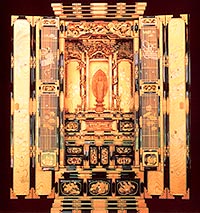Iiyama Buddhist Altar~飯山仏壇
History
Iiyama city is along the Chikumagawa River at the northern end of the Nagano Basin, and next to the Echigo country Niigata Prefecture. Uesugi Kenshin was built in 1579 (Tensho 7), as the castle town of Mr. Honda during the Edo period, it was the starting point of the Chikumagawa boat service and flourished as a material dissemination site. Shimazaki Fujimura's masterpiece's work at the beginning says, "A special city to be used as the first Buddhist land of Shinshu, a small city like seeing the ancient eyes, a strange northern country-style craftsmanship, a roofing roof, or winter snow exclusion From the eaves of the eaves, everything from the eaves of the temple to the trees of the trees of the temple which is high in some places, all the sight of the old town is seen wrapped in smoke of incense. "
There has not been a definite record of when the Buddhist altar was started from around this area. It is certain that the fact that Jodo Shinshu propagated from the Muromachi era from Hokuriku and dropped broadly in Hokushin district, centering on Iiyama, brought about the regional nature as a foundation for making buddhist altars. In general, it is said that the local Teruyuki Takashihide came from Kofu in 1689 (Genroku 2) in the local area and it was the beginning of handling the foundation altar. It seems the truth is that it became to be used painted altar, according to those who were from the Echigo-gata town after a long delay.
At the end of the Tokugawa period, Kinaki Inaba came out, he was a master of sculpture of the Buddhist altar, but this ancestor of the Inaba family lived in Kyoto, Kikuhisa Hikiro, Yoshihiro Hikasa, etc., and returned to Buddhist monastery, reached Ninobe and settled in Iiyama It means that the Iiyama Buddhist altar gave way to the flow of Kyoto, and from the time of Kisaku it was thought that the method of raising its voice was raised and the production method was also differentiated.
Production process
- Woodland process
-
- We will make male and female molds for assembly of parts by "mortise removal", "hole drilling" and "small hole drilling".
- Bonding 5 boards, chamfer it with a plane and make a bow-shaped long press (Nageshi).
- Palace process
- Construct and assemble parts of the palace by "Grafting", "Making Gables", "Making a Submerged Board", "Making Talci", "Build a Kimkoki Braid", "Making a Komaki", "Pillar Nuki".
- Engraving process
- Draw a picture of flowers, flowers, birds and animals, people, etc on the wooden material and carve it with fleas.
- Coating process
- Once you've assembled the woodland, "lose" and paint lacquer. Perform undercoating / sharpening, intermediate coating and sharpening, and perform flower coating with this lacquer, or colored with Lu.
- Decorative bracket process
-
- Make the money fittings by plating → cutting → pattern sword → reddening.
- The material is copper or brass, and various patterns are used to carve complex patterns.
- Makie process
-
- Draw a picture of Peacock · Peony · Chrysanthemum · Tung · Phoenix · Lotus · Kikyo, Hagi · Sansui · Tianjin · Nishi · Kasumi · Urasado etc. on the back of the fan, back door, sliding door, drawer, Karato etc.
- In order to give Makie 's feeling of rest, we use a brush to make a mixture of chalk powder and shellfish powder on top of the illustration, then paint it with lacquer and finish it with gold powder. This is called prime potato makie.
- Gold foil stamping process
- Wipe off the foil undercoat with soft washi paper, then push the gold foil and wipe it with cotton. (How to polish foil) There are two methods of "foil finish" and "gold dust finish"
- Assembly process
- Assemble the finished parts. All Iiyama Buddhist altars that are made by hand are decomposed, washed and re-painted parts, so that they can be revived newly and inherited from generation to generation. To wash and re-paint is called "Washing".
- Iiyama Buddhist altar "Washing"
- Iiyama Buddhist altar is made by assembling timber according to its characteristic "book group". For this reason, pulling out the wedge can break down into individual parts. You can wash and dry the disassembled parts, apply new lacquer and paste gold leaf back. Of course, not only wooden parts but also metallic parts can be washed and painted again, so many years will be born again as new as well as new. We call this "washing the Buddhist altar". It is a wisdom of the predecessors because it is a Buddhist alt presupposed to be used for a long time in many generations.
Work
If Iiyama Buddhist altar made with "this group", Iiyama's Buddhist altar store accepts responsibility for laundry. Please do not hesitate to contact us.
Iiyama Buddhist altar business cooperativeURL:http://www.avis.ne.jp/~butsudan/
2017/05/02
